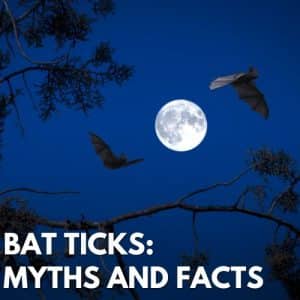
Ticks are becoming one of the greatest threats all over the United States. The adult or the nymph ticks in florida may be active throughout the year. According to sources, people in Florida are affected mainly by the nymphal stages of ticks. Among other areas, the Sunshine state in Florida is highly infected by tick transmission and tick diseases. Learn more about the influence of the specific type of ticks in Florida and how to prevent yourself from getting infected.
Are There Ticks In Florida?
The Ticks in Florida are on the rise due to the humid subtropical climate and the hot and humid summer months throughout the year. The natural environment in Florida is splendid, with a wide variety of wildlife and it is obvious that many pests are common in the state due to the increased number of travelers and tourists, but the main concern is the tick. The CDC reported that Florida had an increase in reported Lyme disease cases since 2015. Like Lyme disease driving deer ticks, there are many species of ticks in Florida. So, be aware of the different types of ticks in Florida to take the proper precautions to keep your surroundings safe. Here are the types of ticks you need to know about in Florida.
To know about the ticks in other parts of the United States , do visit our page.
Ticks in Florida
Gulf Coast Tick:
These ticks are present in the southeastern United States. They are transmitters of pathogens such as Rocky Mountain Spotted Fever. Nymphs are active during spring. Adults may look for hosts from March through September, whereas you can find the nymphs in February through August. The animals which act as hosts for ticks are large, wild, and domestic mammals such as white-tailed deer, cattle, horses, swine, and companion animals. They may consume the blood of coyotes and goats.
They may cause diseases such as;
- Rickettsia rickettsii, the causative agent of Rocky Mountain Spotted Fever.
- Hepatozoon americanum, the causative agent of American canine hepatozoonosis
- Leptospira Pomona, the causative agent of Leptospirosis
The Gulf Coast tick may also cause tick paralysis, another condition that releases neurotoxins into the host. This may lead to unusual symptoms like Heavy breathing, salivation, wobbly legs, etc.
Blacklegged Ticks:
These ticks are also known as bear ticks or deer ticks. Blacklegged ticks are well-known for spreading tick-borne disease – Lyme Disease. The deer ticks take nearly two years to complete their entire lifecycle. Apart from Lyme disease, they may also be a vector to many tick diseases, including babesiosis, anaplasmosis, Powassan virus disease, etc. The larvae and nymphs of blacklegged ticks are active from April through August. The adult bear ticks are active during winter.
Lone Star Tick:
These ticks thrive in regions with underbrush and high grass. They prefer hosts such as white-tailed deer, dogs, cats, and other pet animals. They host them through the process called Questing. Questing is the process where the tick would be present in the grassland with the front legs in the air waiting for the host to stick on. Once the host comes near, they hang on to the host and survive. That is why lone star ticks are generally called the “Questing Tick.”
The diseases they may cause are:
- Human monocytotropic ehrlichiosis (Ehrlichia chaffeensis),
- Canine and human granulocytic ehrlichiosis (Ehrlichia ewingii),
- Tularemia (Francisella tularensis), and
- Southern tick-associated rash illness (STARI), possibly caused by the spirochete Borrelia lonestari.
American Dog Tick:
These ticks are common in shrublands and grasslands. American dog ticks hosts include raccoons, skunks, cats, dogs, and other canids. Larvae and nymphs mainly infest small mammals such as mice, voles, rats, and chipmunks.
They act as vectors to many diseases, including Lyme disease, Ehrlichiosis, Anaplasmosis, Rocky Mountain Spotted Fever, Babesiosis, Bartonellosis, and Hepatozoonosis.
Brown Dog Tick:
Brown dog ticks are called by other names, including brown dog tick, kennel tick, or pantropical dog tick. The tick name contains dog prominently because the most preferred host of brown dog ticks are dogs.
These ticks can cause the following diseases:
- Ehrlichia canis, which causes canine ehrlichiosis,
- Rickettsia rickettsii, the bacteria responsible for causing Rocky Mountain spotted fever
- Babesia canis is responsible for canine babesiosis.
They can also be vectors of diseases such as :
- Babesia Vogeli
- Babesia canis
- Coxiella burnetii
- Ehrlichia canis
- Hepatozoon canis
- Mycoplasma haemocanis
- Rickettsia conorii
They prefer all large mammals like dogs. These ticks are three-host ticks. They tend to consume the blood of different animals in various stages of their life cycle from other hosts. Humans may also become prey to these ticks.
Rare ticks In Florida:
Rocky Mountain Wood Tick:
The Rocky Mountain wood tick is an invasive species found in Florida. Dermacentor andersoni is a tick that feeds on the blood of dogs and cats. It is similar to an American dog tick (Dermacentor variablis). It is abundant on the United States East Coast and commonly found in the southern states, including Florida. It is responsible for transmitting diseases, including Rocky Mountain Spotted Fever and Tularemia. It spreads less disease than the American dog tick in Florida and is less in population. The structure looks similar to an American dog tick. But, if you notice deeply, it seems slightly darker brown compared to the American dog tick, which is light brown.
African Tortoise Ticks:
African tortoise ticks (Amblyomma marmoreum) are common throughout the southeastern United States. The tick is a member of the Ixodidae family ( Hard tick). It is a parasite that infects the skin of small mammals such as rodents, rabbits, and hares, and their preferable host could be the tortoise. It is found in the Florida Everglades, the west coast of Florida, including in the city of Destin. The arrival of the new species native to East Africa. Scientists initially detected its invasion in the United States by their specimen in Collier County ( southern end of Florida Gulf coast) in 2017.
The tick poses a severe threat to wildlife but is also a concern for people. It has been found in dogs and cats and has few natural predators in the Florida wild. The African tortoise tick looks similar to the Lone star tick (Amblyomma americanum). The features that differentiate it from the lone star tick are the absence of white markings in the female scutum and the grayish-black color of the body. Studies depict that similar to lone star ticks, it could transmit the Cowdria ruminantium, which causes Fatal heartwater disease.
Bont tick:
Bont tick (Amblyomma variegatum)is not native to the United States but is likely to invade Florida through the nearest Caribbean islands. It is also called tropical bont ticks due to their adaptability to tropical climate. It is not there in Florida, but researchers note that it could spread soon in Florida like gulf coast ticks. It could transmit African tick bite fever to humans.
Florida Tick Identification Chart:
There are many ticks in Florida, and many are getting invaded too. So it is essential to know the common ticks in Florida to identify them. Look at the chart below to learn about the common ticks of Florida in various forms.
Florida Ticks On Dogs:
Ticks are the bane of the dog owner’s existence. They’re tiny, hard to see, and can hang out on your pup for days before you notice them. If you live in Florida, there’s a vast chance you’ll find a tick on your pet. Florida has a problem with tick-borne diseases. The Department of Health in Florida mentions that in the past five years, the number of Lyme disease cases in dogs has increased by 40%. The American dog and brown dog ticks are abundant in the dogs of Florida. Many dogs will have at least one of these ticks on them. Some of these ticks cause mild illness in dogs and cause spotted fever. The brown dog tick can infect your dog with canine ehrlichiosis. It is a deadly condition with symptoms that include anemia, heart failure, and seizures.
Ticks In South Florida
Ticks are bad. We don’t need to tell you that. But in South Florida, they are even worse. Even the migrated ticks, such as gulf coast ticks, are getting into the United States through South Florida. Ticks in south Florida are a real problem, especially for pets and people who live in wooded areas.
Brown Dog Tick
The brown dog tick is abundant in wooded areas and suburban areas. It is common in the urban setting of south Florida. South Florida is the fourth largest metropolitan area in the United States. The brown dog tick’s predominant indoor habitat is present in all parts of the US without habitat restriction. It is high in number in the central and southern regions of Florida. Miami in south Florida has more brown dog ticks.
Lone Star Tick
Lone star ticks are brown-colored ticks native to the United States. The lone star tick is rounder and larger than the dog tick. The lone star tick makes their life in urban areas of south Florida’s woods and fields. While the lone star tick is native to the southeastern United States, researchers recently found that they have a significant population in South Florida. The tick can potentially spread a fatal disease to dogs. It doesn’t spread any illness to humans so far in south Florida; it has a high chance of extending the alpha-gal syndrome in South Florida. It is due to climate change in South Florida, which will likely impact the spread of tick-borne diseases in years to come.
Deer Tick or Blacklegged Tick
About half of the ticks in the United States are black-legged ticks. These ticks are common in south Florida and can cause severe illnesses in pets and humans. The black-legged tick infestation in south Florida is on the rise. The black-legged tick is a species native to the United States and solely responsible for transmitting Lyme disease. The black-legged ticks are common in south Florida, spreading the bacteria that causes Lyme disease and ehrlichiosis. As the weather warms up in South Florida, you may see an increase in black-legged tick activity.
American Dog Tick
Another common pest in south Florida is the American Dog tick, a vector of RMSF and Tularemia that can cause serious health problems in humans. American dog ticks are small, and their bites are often painful.
When Is Tick Season In Florida?
Tick season is crucial for Floridians. The unfortunate side of this season effect is that it attracts an increased number of these pesky parasites. At the end of May, the threat of tick bites will become even more prevalent. Summer (June- September) in Florida is hot and humid. Ticks can cause serious illness for you and your family. In Spring (late march- may), the weather will be excellent. Unfortunately, it means it’s tick season. The first thing you learn about living in Florida is its tropical paradise. Most of the months will have an active tick population in general. In winter also, winter ticks are getting active. Luckily it is not feeding many humans but mostly attacking their preferable host, moose.
What To Do If Bitten By A Tick in Florida?
Follow the steps that might help you safely remove the tick from your body.
- Expose the tick by pulling it away from your hair gently.
- Use tweezers, grab the tick’s head, and gently pull out the tick from your body. Do not grab the tick’s body as the blood would go in contact with your skin which might lead to infections or tick diseases.
- Pull out the tick in a straight motion. Do not twist or turn the tick.
- If you develop a rash or fever during or after the process, consult your doctor immediately.
Make sure you have a tick checklist before your outdoor adventure in Florida.
Conclusion:
Tick population is increasing in the United States, especially in the country’s eastern regions including Florida. So, it is our responsibility to stay away from ticks and take necessary precautions to keep yourself away from ticks and protect you and your family from getting tick infection and tick-borne diseases.
Frequently Asked Questions
Are there ticks in central Florida?
Central Florida is home to the most beautiful natural areas in the country, and unfortunately, it also attracts ticks. Ticks love warm weather, and Central Florida is their perfect climate. So, if you live in Orlando in central Florida, there are more ticks in the region. Since more tourist spots are there and the season also favors more ticks. For anyone planning a trip to Orlando, Florida, you should know that this city has a very high risk of tick bites. Not only are the chances of getting a tick bite higher in this city, but the possibility of contracting Lyme disease is also a concern.
Are there ticks in southwest Florida?
Many things attract people to Southwest Florida, but ticks are not one of them. While the area is beautiful and the beaches are amazing, it’s also a hotspot for tick-borne diseases like Lyme and other tick-borne illnesses. Southwest Florida’s population is rising, which means it’s a hotbed for ticks. The brown dog tick is most prevalent here. Southwest Florida is near the gulf region so it may get infected by Gulf Coast ticks.

